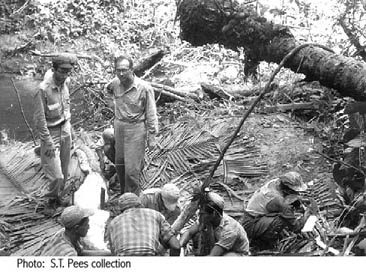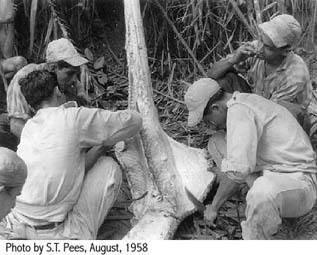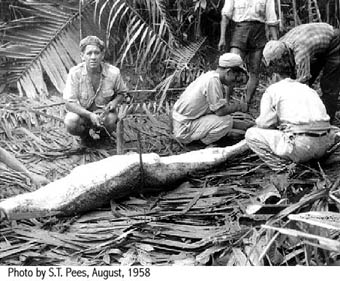 |
||||||
Skinning
Early next morning all of us went to the kill site about one kilometer up the creek. We noticed that the dead snake had moved somewhat and had its tail in the water. Apparently it had underwent reflex actions in the night and had changed position substantially. There were no animal tracks in the mud of the flat so we knew that the dead snake had these spasms on its own and wasn't molested by predators. The water around the tip of the tail was frothy due to a mad mass of piranhas which were eating it. They had consumed about six inches of the tail.
 |
Near Contamana, Eastern Peru, August 1958. Unnamed tributary to Quebrada Maquia, Rio Ucayali drainage system. The Peruvian workmen cut palm fronds to cover the mud and thus provide a work place. In this photo they have commenced to skin the 23' anaconda. Samuel T. Pees (upper left), geologist with Texas Petroleum Company, and Bernhard Kummel, Harvard University. |
The men covered the mud flat with palm fronds and broad leaves to make a work place to skin the snake. The carcass was steadied by stakes driven on either side of it. The men used a sharp machete to make a single slit lengthwise and then pulled the skin away from the body. They had to scrape a lot of tissue off the skin. The last thing to be cut off was the head.
 |
Near Contamana, Eastern Peru, August, 1958. Peruvian field crew skinning the 23' anaconda. |
There was very little blood on the white skinned carcass, only a few drops here and there. However, the men were looking for tear-shaped globules of a fatty substance which they pulled off and carefully wrapped in leaves. They said that this was great medicine, that it could pull the infection out of a bad sore.
 |
Near Contamana, Eastern Peru, August, 1958. The large lumps in the carcass attest to the crocodile which had been swallowed by the anaconda. Field crew is skinning the tail portion of the snake. |
We reached the point in the skinning process where we were ready to cut into the snake's stomach. Much to my surprise, some of the bearers thought that the anaconda had swallowed a human being, perhaps a missionary, they said. Lord knows what anybody would be doing alone in this part of the deep jungle. There were not any other people, just us. I knew that the snake had not swallowed a man.
![]()
| © 2004, Samuel T. Pees all rights reserved |
|